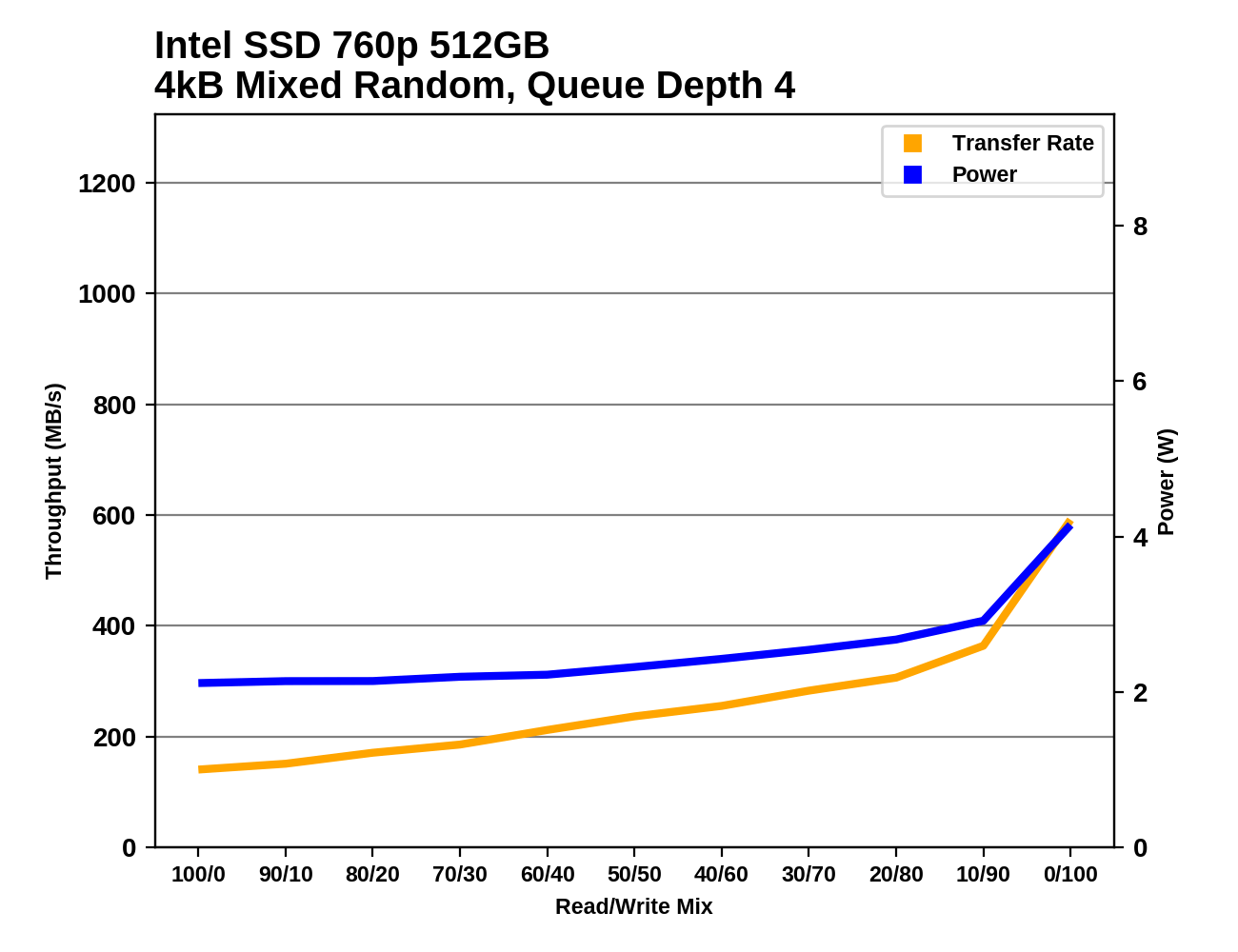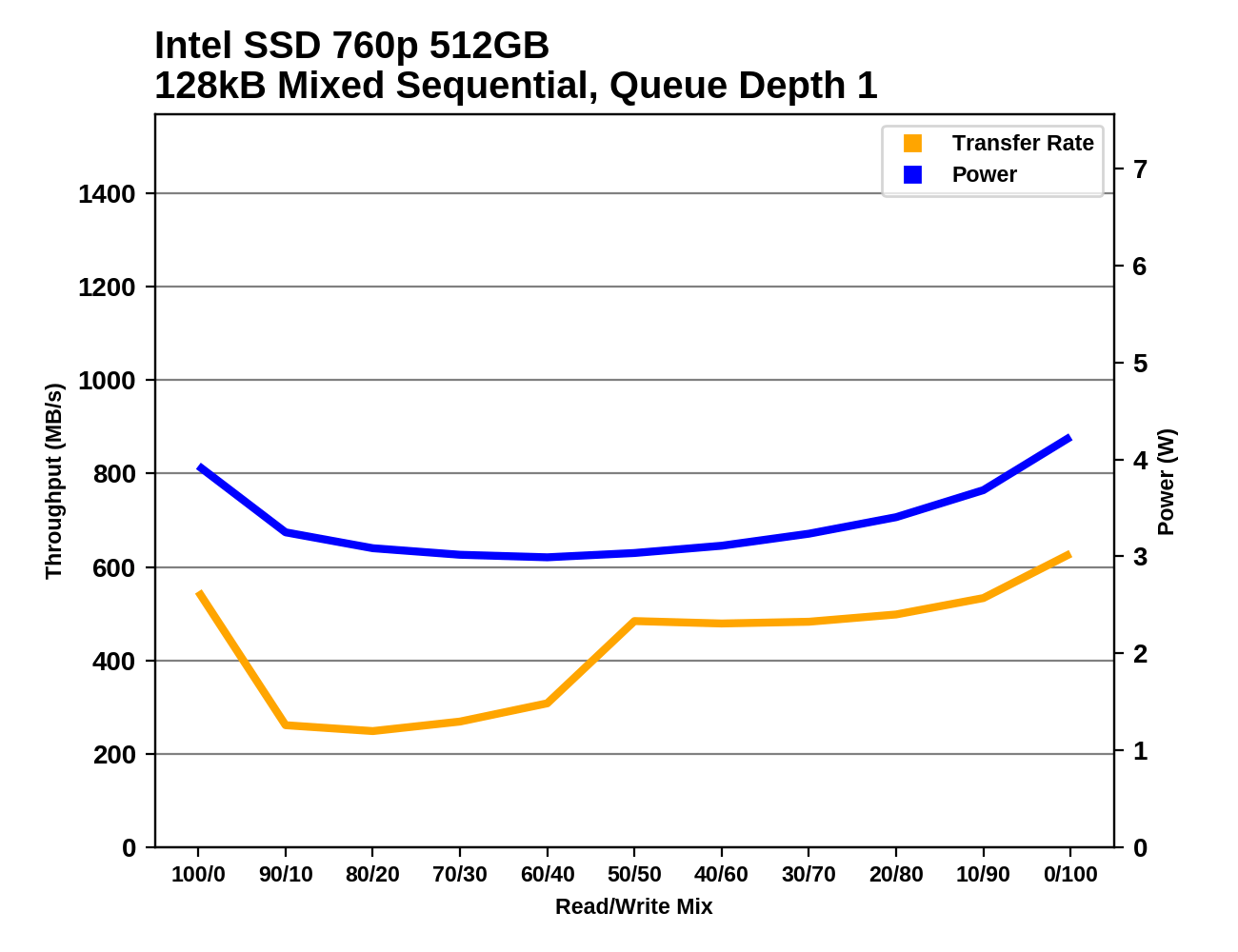The Intel SSD 760p 512GB Review: Mainstream NVMe Done Right
by Billy Tallis on January 23, 2018 11:30 AM ESTMixed Random Performance
Our test of mixed random reads and writes covers mixes varying from pure reads to pure writes at 10% increments. Each mix is tested for up to 1 minute or 32GB of data transferred. The test is conducted with a queue depth of 4, and is limited to a 64GB span of the drive. In between each mix, the drive is given idle time of up to one minute so that the overall duty cycle is 50%.

The overall performance of the Intel SSD 760p on the mixed random I/O performance is quite high for a TLC-based drive. Samsung's PM981 is much better, but the 512GB 760p is almost as fast as the 1TB Samsung 960 EVO. The 760p is clearly a viable competitor to the non-Samsung drives that use MLC NAND flash.

The Intel SSD 760p does not score quite as well for power efficiency as it does for raw performance on the mixed random I/O test, but it is still above average and far better than previous Intel SSDs.
 |
|||||||||
The random I/O performance of the Intel SDD 760p increases gradually but steadily as the proportion of writes increases. It's a good sign that there are no dips in performance along the way, but the performance on the final phase of the test with a pure random write workload is not competitive with the high-end SSDs.
Mixed Sequential Performance
Our test of mixed sequential reads and writes differs from the mixed random I/O test by performing 128kB sequential accesses rather than 4kB accesses at random locations, and the sequential test is conducted at queue depth 1. The range of mixes tested is the same, and the timing and limits on data transfers are also the same as above.

The average performance of the Intel SSD 760p on the mixed sequential workload test does not exceed the limits of a SATA link, but it does clearly beat the best speed achieved by a SATA drive on this test. Previous budget NVMe SSDs have failed to even match the fastest SATA SSDs due to the use of slow TLC NAND.

The power efficiency of the Intel SSD 760p on the mixed sequential I/O test is not great. It only beats drives that were notably slow (600p, WD Black) or unusually power-hungry (Intel 750, Plextor M8PeY). Samsung and Toshiba have set a much higher standard.
 |
|||||||||
The Intel SSD 760p performs much worse during the first half of this test, when the workloads are more read-heavy. By contrast, Samsung's NVMe SSDs tend to be at their worst during the second half of the test. The Samsung drives are much faster at either end of the test when the workload is either pure reads or pure writes, and this helps the Samsung drives secure a clear lead in performance.










51 Comments
View All Comments
Jhlot - Tuesday, January 23, 2018 - link
Right we are comparing EVO not PRO here. And this is Intel's midrange consumer NVME now if Optane is high/enthu and 600p is low, and the 760p still doesn't compare to Samsung's lessor NVME 960 evo consumer from more than a year ago. The 960evo has a small premium in price because it can command it based on performance since no one else is stepping up to its level. Also the OEM 960 evo (PM961) is often available new on ebay for a little over $300 at 1TB which maybe the Intel offering will match. So, an altogether underwhelming showing by Intel is a valid criticism while msabercr's exaggerated Beetle vs. 911 jab which is implicit on price/offering tier not being comparable is misplaced because they are comparable consumer NVME offerings.milli - Thursday, January 25, 2018 - link
Why even compare to the 960 EVO?It barely matches the Toshiba XG5 and there's already a faster XG5-P.
andychow - Tuesday, January 23, 2018 - link
Toshiba is trying to sell their memory chip business, that's why their prices are out of whack and they have no successor. They gutted that division and leave old stock at inflated prices to pretend their brand has some sort of value. Bain must be working some sort of angle to see $18B of value.emvonline - Tuesday, January 23, 2018 - link
it has 2 dram chips? for a 512GB SSD? with average performance? is that normal?svan1971 - Tuesday, January 23, 2018 - link
Intel 50% lower performance for 33% less money than Samsung.HStewart - Tuesday, January 23, 2018 - link
And the new 960 was release today.megapleb - Tuesday, January 23, 2018 - link
Real world testing would be very helpful on SSDs. While the benchmarks are great, as a consumer, what I really care about is how much difference a drive will make to dad to day activities - boot time, application loading etc.niva - Tuesday, January 23, 2018 - link
You won't see much difference in those use cases, maybe some heavy applications might take a second or two longer to load even in the slowest drives. These drives only differentiate themselves in situations where you hammer them with tons of data and instructions.bug77 - Tuesday, January 23, 2018 - link
And that's the "dirty" secret of SSDs: as much as benchmarks show them performing faster or slower, in real life it makes little difference unless your workflow relies on heavy I/O. I can confirm that as I have currently installed Vertex4, 850EVO and MX300 drives and I cannot tell of any difference when using any of them.I've said it before and I'll say it again: when buying an SSD, the only rule to follow is "get the biggest drive you can fit in your budget".
Amandtec - Wednesday, January 24, 2018 - link
Contrarian view: A PC is as much a status symbol as a tool. By your logic no one should buy a BMW because you unlikely to use all that extra speed.